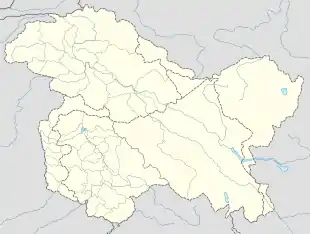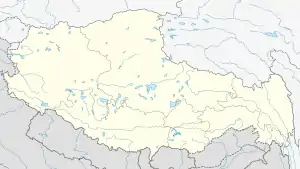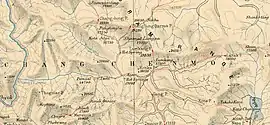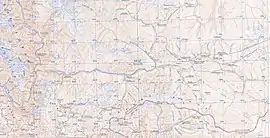Chang Chenmo River
Chang Chenmo River or Changchenmo River is a tributary of the Shyok River, part of the Indus River system.[3] It is at the southern edge of the disputed Aksai Chin region and north of the Pangong Lake basin.
| Chang Chenmo River | |
|---|---|
   | |
| Location | |
| Country | India, China |
| State / Pronvince | Ladakh (India), Tibet (China) |
| Physical characteristics | |
| Source | Lanak La |
| • location | Rutog County |
| • coordinates | 34.3542°N 79.5446°E |
| Mouth | Shyok River |
• location | Ladakh |
• coordinates | 34.2758°N 78.2889°E |
• elevation | 12,000 feet (3,700 m)[1] |
| Length | 70 miles (110 km)[2] |
| Basin features | |
| River system | Indus River |
| Chang Chenmo River | |||||||
|---|---|---|---|---|---|---|---|
| Traditional Chinese | 羌臣摩河 | ||||||
| Simplified Chinese | 羌臣摩河 | ||||||
| |||||||
The source of Chang Chenmo is near the Lanak Pass in the Chinese-administered region of Kashmir (as part of the Rutog County in Tibet).[1][3][4] The river flows west from Lanak La. At the middle of its course lies the Kongka Pass, part of the Line of Actual Control between India and China passes.[5] Continuing west, the river enters a deep gorge in the Karakoram Range until it joins the Shyok River in Ladakh.
Name
Chang Chenmo means "Great Northern" in Tibetic languages.[6] It is primarily the name of the valley rather than the river.[7]
Geography


The Chang Chenmo Valley lies in a depression between the Karakoram Range in the north and the Changchenmo Range in the south. The depression continues into Tibet, all the way to Yeshil Kul (Bangda Co) and Lake Lighten (Guozha Co) on the Khotan border.[8] The depression is now recognized as a geological fault called the Longmu Co fault, part of the larger Longmu–Guozha Co fault system.[9]
The Chang Chenmo River has its origin in a glacier southwest of the Lanak Pass, which lies on a low ridge in the middle of the valley. The southern mountains are much more glaciated than the north and possibly much of Changchenmo's waters are derived from them.
The Changchenmo flows on gravel bed for much of its course, described as "stony and bare". Numerous tributary streams flow into it from the north as well as the south, bringing alluvium. Grass grows in the alluvial beds, which is said to be used by the Ladakhis for autumn grazing. However, there is the ever-present danger of snowfall, which can cover up the grass. Unless the animals can be brought back over the high passes they would be in danger of starvation.[10]
In the middle of the Changchenmo valley, a large spur of the Karakoram Range inserts itself, causing the river to zigzag its way through its hills. The Kongka Pass lies on the last of these hills. To the west of the spur, the large tributary of the Kugrang River flows into the river. To its east the Kyapsang River does the same. Three prominent grazing grounds are found to the west of the Kongka Pass, viz., Kyam (or Kiam, also called Hot Springs),[11] Tsolu (or Tsogstalu), and Pamzal.[12] Another one called Gogra[13] is to the northwest in the Kugrang River valley, where another tributary called Changlung flows into Kugrang.[14]
After Pamzal, the river enters a narrow gorge through the main Karakoram Range, where it becomes a rapid stream. This part of the valley is not traversable except in winter when the river is frozen.[15][16]
Tributaries
In Chinese-administered Aksai Chin, the Changchenmo is joined by Toglung Marpo, Kyapsang,[17] and Silung Kongma.[17]
It crosses the Line of Actual Control to Indian-administered Ladakh at the Kongka Pass. In Ladakh, it is joined by Silung Burma,[17] Silung Yogma,[17] Kugrung River,[18] Rimdi River,[19] and numerous other streams before flowing into the Shyok River.[20]
History
In the late 1800s, in order to facilitate trade between the Indian subcontinent and Tarim Basin, the British attempted to promote a caravan route via the Chang Chenmo Valley as an alternative to the difficult and tariffed Karakoram Pass.[21] The Maharaja Ranbir Singh at the request of the British made improvements to the trails and facilities of the campsites in Chang Chenmo Valley.[22][23] Unfortunately, in addition of being longer and higher elevation than the traditional route, this route also goes through the desolate desert of Aksai Chin.[21][23] By 1890s, traders have mostly given up on this route.[17] At the time, Chang Chenmo valley was also a popular hunting spot for British officers on leave.[24][25]
Since the 1950s, the river is in the disputed territory between China and India.[4] As such, it hosts numerous border outposts from both sides, such as Kongka Pass, Hot Springs, and Tsogstsalu.[26][27] The region was also the site of numerous tensions in the past, such as the 1959 Kongka Pass incident.[26]
References
-
Sharma, Raghav Sharan (6 December 2017). The Unfought War of 1962: An Appraisal. Taylor & Francis. p. 39. ISBN 978-1-351-05636-6.
The tributary originates from Lanak la under Chinese possession.
- Drew, The Jummoo and Kashmir Territories (1875), pp. 327–328.
-
Negi, Sharad Singh (1991). Himalayan Rivers, Lakes, and Glaciers. Indus Publishing. pp. 53–. ISBN 978-81-85182-61-2.
The Chang Chenmo river is a tributary of the Shyok river which joins the Indus river in Ladakh. This river originates from a large glacier on the western slopes of the Lanak La pass
- Bhonsale, Mihir (February 2018). "Understanding Sino-Indian Border Issues: An Analysis of Incidents Reported in the Indian Media" (PDF). Observer Research Foundation. p. 7.
-
Malhotra, A. (2003). Trishul: Ladakh And Kargil 1947-1993. Lancer Publishers. p. 41. ISBN 978-81-7062-296-3.
The Chang Chenmo River. It originates from Lanak La, flows westward and joins the Shyok.
-
Shaw, Robert (1871). Visits to High Tartary, Yârkand, and Kâshgar (formerly Chinese Tartary): And Return Journey Over the Karakoram Pass. J. Murray. p. 81.
Chang-chenmo means "Great-Northern (River)"
- Drew, The Jummoo and Kashmir Territories (1875), p. 327: "Changchenmo is the name of a long valley, tributary to the Shayok [Shyok], which extends nearly east and west for more than 70 miles as the crow flies."
- Trinkler, Emil (1931), "Notes on the Westernmost Plateaux of Tibet", The Himalayan Journal, 3
- Chevalier, Marie-Luce; Pan, Jiawei; Li, Haibing; Sun, Zhiming; Liu, Dongliang; Pei, Junling; Xu, Wei; Wu, Chan (2017). "First tectonic-geomorphology study along the Longmu–Gozha Co fault system, Western Tibet". Gondwana Research. 41: 411–424. doi:10.1016/j.gr.2015.03.008. ISSN 1342-937X.
- Gazetteer of Kashmir and Ladak (1890), p. 256.
- Gazetteer of Kashmir and Ladak (1890), p. 496.
- Gazetteer of Kashmir and Ladak (1890), p. 647.
- Gazetteer of Kashmir and Ladak (1890), p. 334.
- Drew, The Jummoo and Kashmir Territories (1875), pp. 329–330: "Still the vegetation, scarce though it be, is enough to help on the traveller, and even to support the following of one or two families of tent-dwellers who pass a portion of the year in Changchenmo."
- Drew, The Jummoo and Kashmir Territories (1875), p. 329.
- Gazetteer of Kashmir and Ladak (1890), pp. 255-256.
- Ward, A. E. (1896). The Tourist's And--sportsman's Guide to Kashmir and Ladak, &c. Thacker, Spink. pp. 106–107.
Joining the left bank of the river opposite to Kyam are the Silung Yokma, Silung Burma and Silung Kongma. ... cross the Changchenmo valley journey up the Kiepsang stream ... The traders have now almost entirely given up the Changchenmo-Shahidula route to Yarkand.
-
Macintyre, Donald (1993). Hindu-Koh: Wanderings and Wild Sport on and Beyond the Himalayas. Asian Educational Services. pp. 306–. ISBN 978-81-206-0851-1.
the Changchenmo river--a tributary of the Shyok ... proceed up another long glen north of Changchenmo named Kugrang
-
Darrah, Henry Zouch (1898). Sport in the Highlands of Kashmir: Being a Narrative of an Eight Months' Trip in Baltistan and Ladak, and a Lady's Experiences in the Latter Country; Together with Hints for the Guidance of Sportsmen. R. Ward, limited. p. 297.
Rimdi river ... reached the point where the Rimdi flows into the Changchenmo river
- Prabal Sarkar; Jigmet Takpa; Riyaz Ahmed; Sandeep Kumar Tiwari; Anand Pendharkar; Saleem-ul-Haq; Javaid Miandad; Ashwini Upadhyay.; Rahul Kaul (7 July 2008). "Mountain Migrants - Survey of Tibetan Antelope (Pantholops hodgsonii) and Wild Yak (Bos grunniens) in Ladakh, Jammu & Kashmir, India" (PDF). snowleopardnetwork.org. Wildlife Trust of India. p. 21. Retrieved 9 January 2020.
Map of Chang Chenmo Valley
- Kohli, Harish (2000). Across the Frozen Himalaya: The Epic Winter Ski Traverse from Karakoram to Lipu Lekh. Indus Publishing. pp. 86–87. ISBN 978-81-7387-106-1.
the five difficult passes through the Karakorams posed a barrier ... Cayley reconnoitred a route that went through the Changchenmo ranges ... if anything these new passes were higher than the ones they replaced, and the land in between them was also higher. ... The route had another advantage in that trade from British India could flow through Kulu via Changchenmo to Yarkand, completely bypassing the customs officials of the Maharaja at Leh.
- Kaul, Hriday Nath (2003). India China Boundary in Kashmir. Gyan Publishing House. p. 111. ISBN 978-81-212-0826-0.
Ranbir Singh having, at British request, built the road, "serais" and small store houses for grain.
- Accounts and Papers. East India. XLIX. House of Commons, British Parliament. 1874. pp. 23–33.
(p26) The Changchenmo line ... The extra distance and the sojourn for 5 days longer in such a desolate tract (p33) Every endeavour has been made to improve the Changchenmo route--serais having been built at some places, and depots of grain established as far as Gogra
- Hayward, G. W. (1870). "Journey from Leh to Yarkand and Kashgar, and Exploration of the Sources of the Yarkand River". Journal of the Royal Geographical Society of London. 40: 37. doi:10.2307/1798640. ISSN 0266-6235.
Chang Chenmo is now well known, being visited every year by at least half-a-dozen officers on long leave to Kashmir. The game to be found...
- H.I.N. (1902). "Sport in the Changchenmo Valley, Ladakh". The Navy and Army Illustrated. Vol. 15. London: Hudson & Kearns. p. iv.
- Far Eastern Economic Review. 1963. p. 446.
October 19 a party from a permanent Indian post at Tsogstsalu, 60 or 65 miles west of the border claimed by India north of Lake Pangong, set up a temporary camp at Hot Spring, some fifteen miles further east. Three men of this party, who had made a reconnaissance eastward towards a pass called Kongka La, failed to return. A patrol of about twenty therefore departed on the morning of the 21st in search of them, dividing into two groups. According to the Indian account these groups were groups were suddenly attacked with automatic and mortar fire, one from a Chinese force entrenched on a nearby hill and the other from a force on the south bank of the Chang Chenmo river.
- Jindal, Akash (November–December 2018). "The Story of Hot Springs" (PDF). Indian Police Journal. No. Special Issue on Police Martyrdom. pp. 20–33. ISSN 0537-2429. Retrieved 4 January 2020.
(p22) Karam Singh of ITBF was assigned the task of establishing outposts near the Chinese Occupation Line ... “Hot Springs” was barely three Km far from the site where Chinese Army had intruded.
Bibliography
- Gazetteer of Kashmir and Ladak, Calcutta: Superintendent of Government Printing, 1890
- Drew, Frederic (1875), The Jummoo and Kashmir Territories: A Geographical Account, E. Stanford – via archive.org
